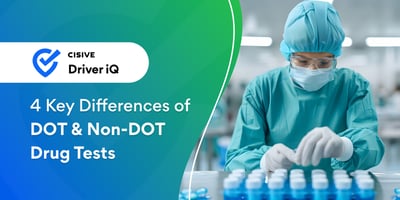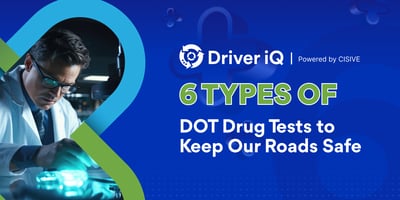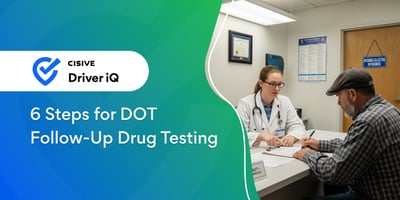%20-%20Blog%20Post.jpg)

No matter how many employees you have, you're responsible for keeping them safe. Employers also...
%20-%20Blog%20Post.jpg)
Drug testing is an important part of maintaining a sober, drug-free environment that can help make your company safer and more productive. Non-DOT drug and alcohol testing is a type of drug testing that isn't regulated, so you have discretion concerning frequency, what drugs to test, and what methods to use.
Drug testing helps ensure new hires are the right fit for your organization. A comprehensive testing program also enhances safety. Partner with Cisive to launch an effective non-DOT testing program.
Here, we'll explain how non-DOT testing differs from DOT testing. We'll also offer tips to help you implement a non-DOT testing program within your company.
Key Takeaways:Here are the key things you need to know about non-DOT drug testing:
|
Employers voluntarily conduct non-DOT drug testing, screening employees without regulation from the Department of Transportation (DOT). DOT drug testing is required for employees who operate certain types of transport, such as planes and buses, that fall under federal DOT regulations.
While employers aren't required to drug test employees for non-DOT regulated positions, many do voluntarily to maintain a drug-free workplace. Substance use not only affects the employee who uses drugs, often leading to problems with productivity, but can also cause issues with safety and affect interactions with customers.
Employers determine the frequency, types, and methods of drug testing since non-DOT drug testing is voluntary and unregulated.
Depending on the method, the employee may be required to go to a lab to give a sample. In some cases, employees can undergo drug testing on the company premises with a mobile drug testing unit.
Once the sample is obtained, it's tested for the specific drugs outlined in the panel.
DOT drug testing is subject to regulations that govern the frequency, type, and methods used, along with other aspects of the testing process. For example, DOT drug testing requires the use of trained sample collectors.
Non-DOT drug testing, in comparison, is more flexible. You can choose to develop a "DOT-like" process, but you're not required to do so. DOT and non-DOT testing have these key differences:
DOT testing is required if you employ commercial drivers who meet one of these requirements:
In contrast, you can perform — or choose not to perform — non-DOT testing for any position. For example, you can test all employees, or you can keep costs low by testing only employees who operate heavy machinery.
DOT Drug Tests |
Non-DOT Drug Tests |
|
|
|
|
|
|
|
|
|
|
|
|
While you may have the ability to drug test whenever you want, costs usually prohibit frequent drug testing. For this reason, most employers do drug testing at certain times. Here are the top use cases of non-DOT drug and alcohol testing:
The most common time employers require non-DOT drug testing is before a prospect is hired. Because this is common and often expected, new hires tend to be on their best behavior regarding substance use when job-seeking so they can pass a pre-employment drug test.
For some companies, this is the only time employees undergo drug testing. For others, additional drug testing during employment helps ensure employees continue to remain sober at work.
Many companies require an annual physical exam, and drug screening is often part of this procedure. Companies that don't require annual physical exams may request stand-alone drug screening at an employee's employment anniversary date.
Similar to pre-employment testing, employees can ensure they pass the test by avoiding substances before the annual test.
For a drug test to be considered random, a predetermined percentage of employees is randomly tested at a predetermined rate. For example, if 50 percent of employees will be randomly tested annually at the rate of once per month, this group would be divided up so that roughly four percent are tested each month for a total of 50 percent being tested for the year.
To ensure fairness, a computerized random number generator draws or selects names, and the same employee may be chosen more than once. This method helps to ensure greater compliance with drug-free policies because employees don't know ahead of time if they'll be tested.
One approach to tampering is the ingestion of large amounts of fluids so that a test will be inconclusive. Another approach is to use commercially available sample substitutes, mostly in the case of urine tests.
Setting the tampering issue aside, some drug tests only detect very recent use. With this knowledge, employees can pass a drug test by carefully planning substance use so that it falls outside of the detection window.
As a general rule, the more reliable and tamper-proof a test is, the more expensive it is. Since the company is the one footing the bill, the need to keep costs down often outweighs the desire for pinpoint accuracy.
While DOT tests are currently always urine tests, you have options when it comes to non-DOT tests. Here are the top methods for non-DOT drug testing:
With this method, the employee provides a urine sample that can be tested for just one substance or many. DOT testing is a standard 5-panel test.
Because urine tests involve some degree of privacy, they're most often subject to tampering. Employees have been known to hide commercially available urine substitutes on their person and submit them as their sample so they can pass a urine test.
With this method, the inside of the mouth is swabbed, and the sample is tested. While this method may seem invasive to some, there's no risk of tampering. However, saliva tests only reveal drug use for the previous 72 hours.
With this method, a hair follicle is removed and tested by cutting a single strand of hair close to the scalp. Significant drug use is deposited at the center of the hair shaft, so this method is considered tamper-proof, despite the availability of topical applications that may remove evidence of drug use.
While the hair follicle test is tamper-resistant, it's more expensive than a urine test. However, it's reliable because it shows a clear picture of significant drug use for as long as three to six months.
With this method, the person breathes into a breathalyzer that can detect alcohol. While this method is highly accurate for alcohol, effective technology has not been developed for other substances.
A blood test is rarely used because it's expensive, invasive, and has a narrow window of detection. If you order a blood test, a trained phlebotomist will collect a blood sample by inserting a needle in one of the employee's veins. Blood testing identifies several drugs, including cannabis, cocaine, amphetamines, and opioids.
Cisive's drug testing service offers mobile, on-site, and lab-based sample collection. Pre-employment screening includes urinalysis, saliva, and hair follicle tests.
We also offer online drug test scheduling and paperless drug test collections. Cisive drug testing offers both DOT and non-DOT for your drug and alcohol testing programs.
Driver iQ is Cisive's transportation employment screening division that includes previous employment and safety information about prospective drivers. Driver iQ reports positive drug or alcohol test results for the previous three years.
Screening with Driver iQ includes employment history and Pre-Employment Screening Program (PSP) reports. Information comes from the Federal Motor Carrier Safety Administration (FMCSA) and Motor Carrier Management Information System (MCMIS) records checks, which include accident reports.
Drug testing improves safety, helps to maintain productivity, and supports a consistent and positive customer experience. As an employer, you have control over when and with what method you want to conduct non-DOT drug testing.
Partner with Cisive for flexible, convenient, and comprehensive drug testing options. Whether your company would benefit from on-site, mobile, or lab-based sample collection, Cisive has the options your company needs to make drug testing a seamless part of your organization's operation.
To find out more about Cisive’s drug testing service, speak to an expert today.

No matter how many employees you have, you're responsible for keeping them safe. Employers also...

If you employ commercial drivers, your company is responsible for maintaining a formal drug testing...

When drivers fail a DOT-mandated drug or alcohol test or refuse to take one, they create...